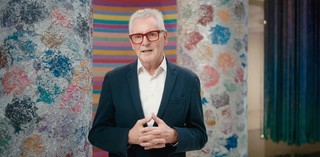With a population of approximately 480,000 by 1953 (when Kenneth Jack painted Grey Street Bridge), Brisbane in the 1950s still retained a relaxed pace of life compared to its southern capitals (Sydney's population was some 1,800,000), keeping its unique charm as ‘Australia’s biggest country town’ even later during a period of growth and modernisation.
Brisbane lacked any high-rise buildings at the time, the City Hall and its clock tower (illustrated) completed in 1930, was still the most prominent landmark that could be seen, dominating the skyline for 40 years until Brisbane entered the age of the skyscraper in 1970. To get around, people caught trams from the city centre (illustrated) out into the suburbs up until 1969. Shops opened on weekdays from 9 to 5, and closed at 1pm on Saturdays, Sundays were a day for rest or recreation. Saturday and Sunday all-day retail trading wasn't introduced until 2002.
View of Brisbane to the City Hall’s clock tower with the Commercial Rowing Club Boathouse in the left foreground c.1930
View across Brisbane City c.1950s
Trams in Queen Street, city centre, 1954
Watch | A portrait of Brisbane, 1954
Therefore, the serene print Grey Street Bridge, Brisbane 1953 by Kenneth Jack (1924–2006) fits perfectly against the backdrop of a laid-back Brisbane in the 1950s. The linocut shows the influence of the contemporary Japanese tradition of Shin-hanga ('New prints'), a movement that emerged in the 1920s in response to increasing artistic exchange with Europe and the United States. Jack has borrowed from the form to capture a corner of the Brisbane River that looks across to Kurilpa Point (now the site of the Gallery of Modern Art – GOMA) and the Grey Street Bridge (renamed the William Jolly Bridge in 1955) with the O'Connor Boathouse & The Commercial Rowing Club featured.
View towards Commercial Rowing Club Boathouse, 1954
Kenneth Jack Grey Street Bridge, Brisbane 1953
Commercial Rowing Club Boathouse
Denis O'Connor was one of the most prominent and popular business figures in Brisbane, a successful rower and administrator who served as President of the Commercial Rowing Club, and Queensland Rowing Association, he also assisted with the funding of the new Commercial Rowing Club Boathouse which was named in his honour. The O'Connor Boathouse & The Commercial Rowing Club (illustrated) located at North Quay replaced the original boathouse erected in 1897, and at the time of its opening in October 1905 was the largest in Australia.
Commercial Rowing Club, November 1905
Jack’s linocut captures a slice of Brisbane history and features the O'Connor Boathouse, which appears on the riverbank in the mid-ground of the print, announced by the sign 'BOATS & CAN[OES] FOR HIRE'. The building traded as a boathouse at river level, on the second floor a gathering place for spectators of regattas on the Town Reach, a space for functions, and a dance hall which became a hub for Brisbane’s lively dance-band scene in the 1950s and 60s.
Queensland Eights at the Commercial Rowing Club, 1911
Rowing regatta, c.1915
Lost Brisbane
The Boathouse, a Brisbane landmark for 63 years was lost to an arson attack on 1 September 1968, the same evening the nearby Supreme Court Building which opened in 1879 (illustrated) was severely damaged by fire and subsequently demolished. The boathouse was removed to make way for the Riverside Expressway which was opened in July 1976.
Margaret Olley Law Courts, Brisbane 1966
The Supreme Court building, c.1910
Commercial Rowing Club Boathouse & Supreme Court Building, c.1930
Edited curatorial extracts, research and supplementary material sourced and compiled by Elliott Murray, Senior Digital Marketing Officer, QAGOMA
Adel Abdessemed’s work Head on 2007–08 playfully alludes to a ‘light-bulb moment’ of inventive thought and is based on a freehand drawing of a brain. Its intersecting lines of neon light depict the complex pattern of the cerebral cortex — the outer layer of the human brain, which controls memory, thinking and consciousness. The brain also processes our sensory experiences and shapes how we perceive the world, influencing our capacity for wonder.
Abdessemed is known for poetic works that reflect on the beauty and fragility of life. Within this monumental but simple line drawing — a drawing in light — the artist suggests the capacity of the brain to comprehend the richness of human experience.
Drawing occupies an important position in Abdessemed’s body of work and, while he rarely exhibits conventional works on paper, the practice of drawing informs his works, describing drawing as a way of 'making decisions' and stated that, 'you can’t lie, there is no place for lying in drawing, it’s all there'.
If you’re wondering, the work was produced in Brisbane according to neon bending plans and detailed instructions provided by the artist, and is able to be serviced locally should the neon gas require replacement.
Three metres high, Head on dwarfs the viewer, its soft glow enveloping its surrounding. We've given the background colour a change, so keep and eye out for the neon at the entrance to ‘Wonderstruck’, accompanied by Lindy Lee’s lively bronze form Unnameable.
Wonderstruck
28 June – 6 October 2025
Gallery of Modern Art
Gallery 1.1 (The Fairfax Gallery), Gallery 1.2 & Gallery 1.3 (Eric and Marion Taylor Gallery)
Brisbane, Australia
Free entry


